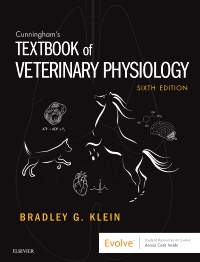
Textbook of Veterinary Physiology - Elsevier eBook on VitalSource, 6th Edition
Elsevier eBook on VitalSource

Help your undergraduate veterinary students understand normal body functions before learning about the mechanisms of veterinary disease. Cunningham's Textbook of Veterinary Physiology, 6th Edition approaches this vast subject in a practical, user-friendly way that helps students grasp key concepts and learn how they relate to clinical practice. From cell physiology to body system function to homeostasis and immune function, this comprehensive text provides the solid foundation needed before advancing in the veterinary curriculum. In addition, a test bank on the Evolve site emulates the NAVLE board exam to give instructors an easy way to develop tests and evaluate student results.
Newer Edition Available
Textbook of Veterinary Physiology - Elsevier eBook on VitalSource
-
- NEW! Updated animations added that are relevant to content.
- NEW! New contributors lend their unique perspective and expertise to the content.
- Clinical Correlations boxes present case studies that illustrate how to apply physiology principles and concepts to the diagnosis and treatment of veterinary patients.
- Practice questions at the end of each chapter test student understanding of what they’ve just read and provide valuable review for exams.
- Expanded resources on the companion Evolve website include state-of-the-art 3D animations, practice tests, a glossary, and Clinical Correlations.
- Key Points at the beginning of each chapter introduce new concepts and help students prepare for exams.
- Full-color format highlights helpful information and enhances learning with a wealth of illustrations that visually depict specific functions and conditions.
-
- NEW! New contributors lend their unique perspective and expertise to the content.
-
Section I: The Cell
1. The Molecular and Cellular Bases of Physiological Regulation
2. Cancer: A Disease of Cellular Proliferation, Life Span, and DeathSection II: Neurophysiology
3. Introduction to the Nervous System
4. The Neuron
5. The Synapse
6. The Physiology of Muscle
7. The Concept of a Reflex
8. Skeletal Muscle Receptor Organs
9. The Concept of Lower and Upper Motor Neurons and Their Malfunction
10. The Central Control of Movement
11. The Vestibular System
12. The Cerebellum
13. The Autonomic Nervous System
14. The Visual System
15. Cerebrospinal Fluid and the Blood-Brain Barrier
16. The Electroencephalogram and Sensory-Evoked Potentials
17. HearingSection III: Cardiovascular Physiology
18. Overview of Cardiovascular Function
19. Electrical Activity of the Heart
20. The Electrocardiogram
21. The Heart as a Pump
22. The Systemic and Pulmonary Circulations
23. Capillaries and Fluid Exchange
24. Local Control of Blood Flow
25. Neural and Hormonal Control of Blood Pressure and Blood Volume
26. Integrated Cardiovascular ResponsesSection IV: Physiology of the Gastrointestinal Tract
27. Regulation of the Gastrointestinal Functions
28. Motility Patterns of the Gastrointestinal Tract
29. Secretions of the Gastrointestinal Tract
30. Digestion and Absorption: The Nonfermentative Processes
31. Digestion: The Fermentative Processes
32. Postabsorptive Nutrient UtilizationSection V: Endocrinology
33. The Endocrine System
34. Endocrine Glands and Their FunctionSection VI: Reproduction and Lactation
35. Control of Gonadal and Gamete Development
36. Control of Ovulation and the Corpus Luteum
37. Reproductive Cycles
38. Pregnancy and Parturition
39. The Mammary Gland
40. Reproductive Physiology of the MaleSection VII: Renal Physiology
41. Glomerular Filtration
42. Solute Reabsorption
43. Water Balance
44. Acid-Base BalanceSection VIII: Respiratory Function
45. Overview of Respiratory Function: Ventilation of the Lung
46. Pulmonary Blood Flow
47. Gas Exchange
48. Gas Transport in the Blood
49. Control of Ventilation
50. Nonrespiratory Functions of the LungSection IX: Homeostasis
51. Fetal and Neonatal Oxygen Transport
52. Acid-Base Homeostasis
53. ThermoregulationSection X: The Immune System
54. Antigens and Innate Immunity
55. The Specific Immune Response: Acquired ImmunityAppendix A: Answers to Practice Questions



 as described in our
as described in our 